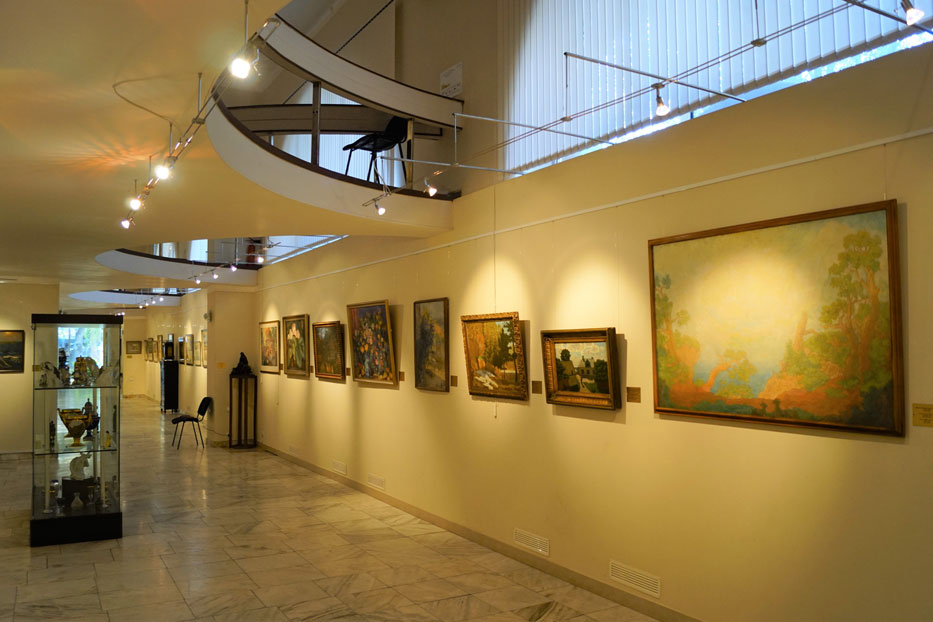The artists represented in this hall - Martiros Saryan, Artur Fonvizin, Pyotr Utkin, Pavel Kuznetsov, Nikolai Sapunov, Nikolai Krymov, along with other symbolist artists, were part of the “Blue Rose” artist association, which was named after the 1907 exhibition of the same name. They were fellow students of the Moscow School of Painting, Sculpture and Architecture (MSPSA). A special role in their development was played by teachers V. Serov and K. Korovin.
Artists P. Kuznetsov and P. Utkin were the core of the group. They met in their native Saratov. This city, which gave life to Russian artistic symbolism, was also the birthplace of Viktor Borisov-Musatov - the mastermind of the “Blue Rose” artists and one of the fathers of Russian symbolism. His works were distinguished by a nostalgic longing for the past of Russian estates and the poeticization of a bygone era.
In the future, already in Moscow, other “Blue Rose” artists joined P. Kuznetsov and P. Utkin. Blue, lilac and light blue pastel colors are characteristic for their symbolist painting, as well as a mysterious smoky coloring and dreaminess, a cult of exquisite beauty. They paid special attention to the musicality, poetry and theatricality of the works.
Not all of the works from the “Blue Rose” collection of the Museum coincide chronologically with the early symbolist period of their artists’ creativity. Thus, the “Yellow flowers” by M. Saryan from his “Small City Flowers” series, created in Goghtn historical province of Armenia, was made in the post-symbolist period of establishing Saryan’s own style.
The eminent Russian landscape painter N. Krymov spoke of himself: “I can only paint bushes and fences, but this I do best of all.” He is represented in the museum with works of different years, including one of his best symbolist canvases - “Dawn” landscape.
A. Fonvizin, one of the young rebels of MSPSA, also joined some avant-garde groups. The thematic range of his works was formed from the vivid impressions of early childhood about the circus and the farcical performances. Since the late 1920’s the artist switched to the technique of watercolor, which became his vocation for life. Since the beginning of the 1940s, the main theme of Fonvizin's work has become portraits of theater actresses in stage costumes, drawings of circus shows, sketches from pre-revolutionary life, flowers and landscapes.
P. Kuznetsov, M. Saryan’s fellow student and friend, like the patriarch of Armenian painting, traveled a lot. If M. Saryan is considered a singer of the Middle East, then P. Kuznetsov – of Central Asia. Steppe landscapes of the Central Asia and Volga, scenes of nomadic life, typical for his creativity, are sustained in the same blue and light blue smoky tones, filled with a sense of eternity and the inviolability of the universe, where everyday plots and simple images are interpreted beyond of the space and time boundaries. In the museum, P. Kuznetsov is represented quite extensively by works of both the early symbolist and Soviet periods.
P. Utkin is one of the brightest and most consistent symbolists. His works are characterized by decorativeness, mysterious images, poetry and sophistication, the predominance of blue and gold, herewith - an extraordinary variety of shades within this palette. These artistic features of P. Utkin’s works can be traced on the example of one, typical for him work – “Moonlight Night.”
A special place in the history of Russian artistic symbolism belongs to N. Sapunov, who died tragically at a young age, but left a huge mark in the Russian art of the turn of the century. In the Museum N. Sapunov is represented quite widely with most typical genres - color still lifes, scenes of secular festivities, fanned with a haze of mystery. N. Sapunov was one of the leading theater artists of the era of “modern” and pre-avant-garde, who has cooperated with famous Russian theater innovators.



